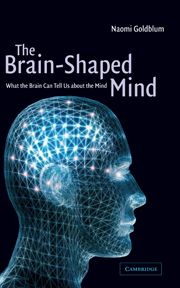Book contents
- Frontmatter
- Contents
- Preface
- Figure permissions and acknowledgments
- 1 Introduction
- 2 What the brain cannot tell us about the mind
- 3 How neurons form networks
- 4 Theories and models of how the mind functions
- 5 What are connectionist networks?
- 6 How our networks learn
- 7 Connecting the networks: how different things are related
- 8 Evidence for connectionist models
- 9 Two different types of memory
- 10 Coping with disaster
- 11 Practical implications
- 12 Criticism of connectionist theory
- Annotated references and suggested readings
- Index
6 - How our networks learn
Published online by Cambridge University Press: 02 December 2009
- Frontmatter
- Contents
- Preface
- Figure permissions and acknowledgments
- 1 Introduction
- 2 What the brain cannot tell us about the mind
- 3 How neurons form networks
- 4 Theories and models of how the mind functions
- 5 What are connectionist networks?
- 6 How our networks learn
- 7 Connecting the networks: how different things are related
- 8 Evidence for connectionist models
- 9 Two different types of memory
- 10 Coping with disaster
- 11 Practical implications
- 12 Criticism of connectionist theory
- Annotated references and suggested readings
- Index
Summary
How could the sort of connectionist networks described in the previous chapter come into being? How can the neurons in our animal-image network, say, become connected up in just the right way to the neurons in our animal-name network, so that the pattern of activity produced in the animal-image net by the sight of a dog leads to a pattern of activity in the animal-name net that makes us think of the word “dog”?
If each concept were represented by a single node, as in the old semantic network theories, the answer to this question would seem to be simple. It seems as if all we would have to say is that the node representing the image of a dog is connected with the node representing the word “dog.” But behind this apparent simplicity lies a great difficulty. How do the two nodes become connected? What force could link up the dog-image node precisely with the dog-name node and not with any other node? Just as there cannot be any “little person” inside looking at little pictures in our brains, there also cannot be any “little person” linking up the proper nodes. Then how are they linked up? The single-node theory may seem to provide a simpler description of the connections between concepts, but it is very difficult to explain learning in such a system.
In connectionist networks, however, as we saw in the previous chapter, dog images and cat images are different patterns of activity on the animal-image network, while the words “dog” and “cat” are different patterns of activity on the animal-name network.
- Type
- Chapter
- Information
- The Brain-Shaped MindWhat the Brain Can Tell Us About the Mind, pp. 54 - 65Publisher: Cambridge University PressPrint publication year: 2001



